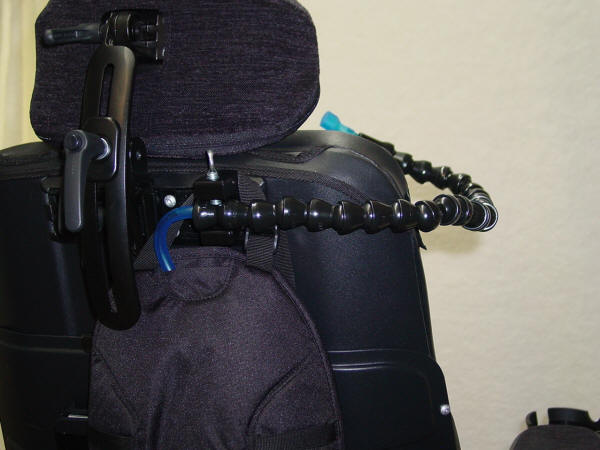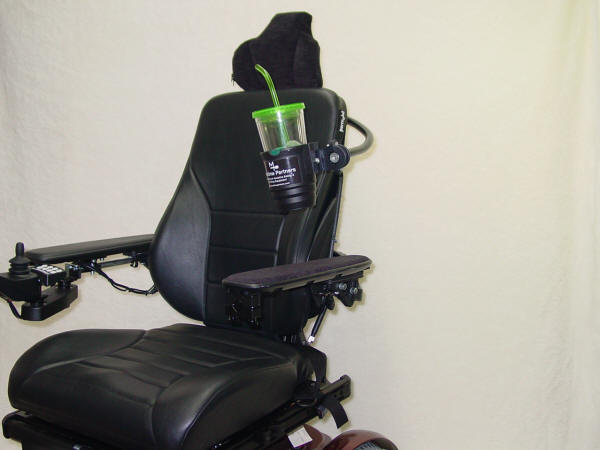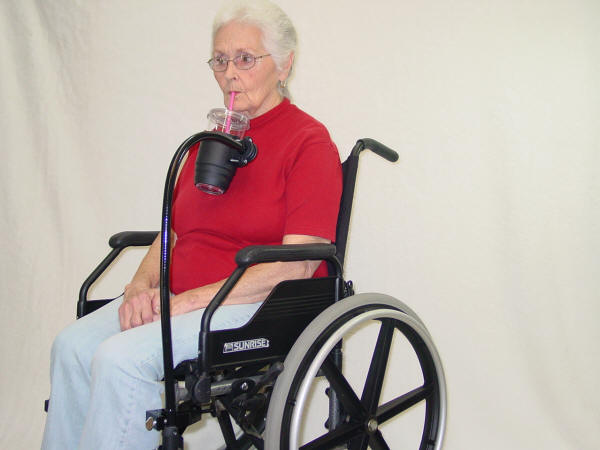June 2019 Independent Eating and Drinking Newsletter
| Independent Eating and Drinking are Wonderful |
 |
| June Newsletter Topics: |
|
| Subscribe to Newsletters |
Gastroparesis (Delayed Gastric Emptying)
Gastroparesis is a disorder that causes food to move very slowly from the stomach into the small intestines or even stop moving completely. Gastroparesis literally means stomach paralysis (gastric = stomach; paresis = paralysis). The stomach is not truly paralyzed but the vagus nerve that controls the muscle activity of the stomach, does not function properly when gastroparesis is present. Gastroparesis is a diagnosis that is made when the possibility of an obstruction in the gastric system has been ruled out. The body’s gastric system is a structure made up of tubes that begin at the mouth and end at the anus. The stomach is a sack that is positioned within the gastric “tube” under the left lower rib cage. When empty, it is quite small (about the size of one-half cup, using cooking measurements).
When we eat, food fills the stomach and the muscles of the stomach relax allowing it to expand to accommodate as much as 3 pints of liquids and solids. There is a valve at the entrance to the stomach, which opens and closes to allow foods and liquids to enter the stomach. Once they have passed through the valve, it closes to stop the contents of the stomach from passing back up into the esophagus. At the lower end of the stomach is another valve that permits digested food to pass into the small intestines. Both valves should remain closed while food is being dissolved in the stomach by strong digestive juices. The muscles of the stomach contract and relax to allow the digestive juices to liquefy the solids that have been eaten. When fully liquefied, the texture of the stomach contents will resemble cream of potato soup. Once this process is complete, the pyloric valve at the bottom of the stomach will open and close allowing a small amount of digested food to pass into the small intestines where liquid nutrients are absorbed into the body. This is a fully automatic body function which takes care of digesting food and emptying the stomach.
When this process works properly we feel full when we have eaten; then gradually, as our stomach becomes empty, the feeling of fullness dissipates. If the process of emptying the stomach, by which the pyloric valve opens and closes releasing small amounts of stomach contents, does not work correctly, stomach emptying can be delayed or not happen at all. Under these circumstances the feeling of fullness remains as the stomach is still full. A feeling of bloating can occur, or, if foods remain in the stomach too long, nausea and vomiting can ensue.
The symptoms of gastroparesis include a feeling of fullness after meals, that does not dissipate over time, distention of the belly, nausea, burping, acid-reflux, and vomiting of food that is undigested a few hours after it has been eaten. This results in a lack of appetite due to the stomach still having food in it hours after the last meal. Also, the fear of vomiting can cause reduction in eating and result in weight loss. The most common identified cause of gastroparesis is insulin dependent diabetes. About 20% of individuals who have diabetes (particularly those who have neuropathy, or nerve damage, associated with their diabetes) show symptoms of gastroparesis. Other disorders that are known to be associated with the occurrence of delayed gastric emptying include Parkinson’s disease, kidney failure, and thyroid disorders. However, approximately 30% of cases of gastroparesis have no identifiable cause.
Before diagnosing gastroparesis, the possibility of an obstruction in the gastrointestinal tract (GI tract) must be ruled out. Obstructions can be caused by ulcer disease, scar tissue, or stomach cancer. Additionally, an obstruction called a bezoar, which is a ball of undigested vegetable material in the stomach, can be found. These conditions are identified by conducting an upper GI series of x-rays using barium to show the passage of food through the GI tract. Additionally, a Gastroscopy is conducted. A scope is passed through the mouth and into the stomach to look for problems and rule out possible issues. Lastly, a radioisotope gastric-emptying scan is conducted. The patient ingests a small quantity of radiation which is tracked as it passes through the body. The test usually takes 2 to 4 hours. Gastroparesis is diagnosed if more than half of the food eaten remains in the stomach after 2 hours.
Currently there is no cure for gastroparesis; the treatment to control it can be as simple as a change in diet and eating food that is easy to digest, eating small meals six times a day, avoiding fatty foods, and not eating high fiber foods that are slow to be digested.
If a change in diet does not control the symptoms, medications are available that can stimulate the stomach muscles, control nausea, and increase appetite. In rare cases that do not respond to treatment, surgical intervention may be considered. A jejunostomy feeding tube (J tube) may be placed directly through the abdominal wall, into the intestines to provide appropriate nutrition to the individual directly into their intestines avoiding the stomach that does not empty properly. For those who are fed using a J tube, specially designed formula is required that provides the appropriate nutrients.
Gastroparesis can affect people of all ages. It is particularly difficult to identify when it occurs in infants and small children because they are unable to express how they feel or cooperate with the conduct of tests. It can occur in children who have health issues like neurologic disorders, and genetic/metabolic disorders, delays in development, premature birth, etc., or who have had a viral infection.
Delayed gastric emptying occurs more commonly in individuals who have other illnesses or disabilities and can be helped by eating a diet that is easy to digest and by consuming several small meals throughout the day rather than three big meals. For those who are unable to feed themselves, an assistive dining system can facilitate their being able to eat many small meals throughout the day, at a leisurely pace, without demanding a great deal of time from their care provider. Click here for information about the Mealtime Partner Assistive Dining System.
| HOT WEATHER IS HERE - MAKE SURE YOU KEEP HYDRATED |
|
A hands-free drinking system can enable someone to drink independently
throughout the day without needing help! Having a drink available allows you to
drink frequently and never get thirsty. Mealtime Partners various drinking systems allow many individuals who are unable to use their hands to take a drink, to drink independently. The Hydration Backpack with Drinking Tube Positioning (pictured below) provides hands free drinking throughout the day for those who sit in a wheelchair and are unable to lift or hold a cup or glass. The drinking system is quick and easy to set up, the water container fits on the back of a wheelchair and the drinking tube can be positioned to meet the unique positioning needs of each individual. |

|
| Easy to install and remove from the wheelchair to fill or clean. |

|
| Hands-free drinking, 70 fluid ounces of water available for people on the go! |
| The Front Mounted Drinking Systems pictured below, can position a variety of cups and drink containers very close to the user's mouth for hands free drinking and allows a variety of other drinks to be made available throughout the day. For example, coffee in the morning, ice tea with lunch, a can of soda in the afternoon and a glass of milk before bed. The user drinks from their own container using a straw. Because the straws and most of the containers can be disposed of, or washed in a dishwasher, it is the easiest drinking system to clean. It is available with several lengths of flex-arms and can be mounted on a variety of wheelchairs. |

|
Front Mounted Drinking System on Wheelchair with
Slide Track Mounting Rails Front Mounted Drinking System on Manual Wheelchair |
| All of the Mealtime Partners drinking systems are available for attaching to manual wheelchairs (i.e., wheelchairs with a tubular handle or other tubular structural components, as pictured above) and for powered wheelchairs with slide track mounting rails. To order any of our drinking products, click here, or call us at 800-996-8607. |
Using Straws for Safer Drinking
During a recent presentation about assistive technology for eating and drinking, the presenter touched upon the use of different types of straws and one-way valves. The question and answer period brought lots of questions, many of which did not get addressed because of time constraints. It was obvious that many people are interested in knowing more about this topic, but it is not a subject that is generally addressed in any kind of detail, possibly because it seems so insignificant. However, it is an important topic that can lead to success or failure with independent drinking. Because of Mealtime Partners comprehensive background in eating and drinking equipment we are aware of the pros and cons of different types of straws and about one-way valves. We hope that the following article will provide details about straws and give insight into how to choose the best equipment for each individual.
Drinking through a straw or tube is an easy way to get liquid without having to lift and/or tip a cup or glass. Drinking through a straw puts the consumer’s head in a downward position. This position creates a chin-tuck that facilitates safe swallowing. However, not all straws are created equal and this article will examine the pros and cons of different types of straws and drinking tubes and how they relate to different users. This article will focus on drinking thin liquids. It will not address considerations relating to the thickness of liquids being consumed.
There are many reasons why one type of straw doesn’t meet the needs of everyone. A few of the reasons are:
-
Some people cannot pucker their lips into a tight enough “kiss” to make a seal around the straw.
-
Others can only create a vacuum when the straw is placed into their mouth to the left or right, rather than centered, which completely prohibits them creating a pucker around the straw.
-
Others need to tighten their jaw into a “bite” to be able to stabilize it sufficiently to be able to create enough suction to pull liquid up a straw. This action will crush many straws.
-
Others have a bite-reflex that will crush soft straws.
-
For others, consistent and extended lip closure is difficult.
The common differences between straws are: the diameter of the straw, the length of the straw, the flexibility of the straw, the rigidity of the straw, and, whether the straw is disposable or reusable.
The Diameter of Straws: The diameter of straws varies from very small, like those found in Juice Boxes, to some that are as big as 3/8 inch in diameter. For straws with a small diameter the user can either pucker their lips tightly to create a seal around them, or, the smallness of the straw allows them to purse their lips (i.e., press their lips tightly together rather than a pucker), resulting in lip closure that allows suction. Juice Box straws are quite rigid and do not easily crush unless they are bitten with teeth. For larger diameter straws, users must be able to pucker their lips. Also, larger diameter straws facilitate drinking somewhat thicker liquids, like soup, milkshakes, etc.
The Length of Straws: The ability to use longer straws depends upon the user’s capacity to suck (i.e., create a vacuum in their mouth). When all else is equal, it is easier to suck liquid through a short straw than through longer lengths. If a user has good suction, using a longer straw allows them to have their drink holder positioned farther away from their mouth.
The Flexibility of Straws: The common use of the term flexible straw refers to a disposable straw that has a short corrugated section close to one end of the straw. This allows the straw to be bent and positioned for access by the user. This type of flexible straw can be inexpensively purchased in boxes at the grocery store. They are commonly used in hospitals when it is impossible to have the user sit up completely to take a drink. It should be remembered that this drinking position (i.e., reclining) puts the user at risk of aspiration, but in some circumstances, cannot be avoided. Many people like the angle that can be achieved using flexible straws because it allows the end of the straw to be positioned directly in front of their mouth.
Another form of flexible straw is made of polyethylene. Polyethylene reusable straws are somewhat pliable and, therefore, can bend. Also, they can accommodate being bitten by the user without collapsing.
The Rigidity of the Straw: Some reusable straws are made of Plexiglas® and are completely rigid. They have the advantage that they can be heated with a heat gun and bent to accommodate the user’s positioning needs. After cooling, the bends in the tube will be permanently maintained. However, due to the rigidity of these straws, an individual will probably be required to use it when it is positioned in the center of their lips to create a good seal. They must also be able to pucker their lips, and they do not need to clench their jaw over the straw to be able to suck. Rigid straws have an additional benefit in that they will not crush if they are bitten.
Disposable Straws: Disposable straws can be purchased by the box at grocery stores, either unwrapped or individually wrapped. Almost all straws that are sold at grocery stores are 7 ½ to 8 ½ inches long and have an approximate (outside) diameter of ¼ inch. Many different length and diameter disposable straws are available at fast food restaurants, convenience stores, or bars. Often these organizations are willing to sell or give a box of straws to someone who asks for them. Disposable straws are very convenient to use because they can be used once and thrown away. This is an important hygiene consideration because straws are very difficult to wash. Disposable straws have one serious short coming for some individuals, they crush when bitten. And, once bitten, the flow of liquid is restricted or stopped.
Reusable Straws: Many cups and bottles, including some sold by Mealtime Partners (MtP Drinking Systems), are supplied with reusable drinking tubes as part of their structure. Also, reusable straws can be purchased separately. They come in assorted lengths and rigidity of material. The diameter of most straws range from 1/8 inch to 1/4 inch and the lengths vary from 7 inches to 18 inches. Many reusable straws, even if they are too long, can be cut to shorter lengths. However, if they are cut, special attention should be paid to the end that is cut to be sure that the straw does not have any sharp edges. A fingernail file or fine sandpaper can be used to smooth rough edges. Also, be sure to properly sanitize the straws before use, if cutting is required.
It should be noted that currently there is a move to discontinue the use of one-time-use straws as they contribute to the amount of plastic waste that is being added to landfills on a constant basis. However, for some individuals who have disabilities, they are an important part of maintaining their hydration.
Hygiene is another issue when using reusable straws. It is difficult to be sure that they are well cleaned and sterilized. If the user bites down on the straw, after a few uses special attention should be paid during washing to the teeth marks at the end of the straw. Small brushes to clean the inside of the straw are available from Heart Rate Monitors, and health department recommendations for institutional cleaning should be used to clean all straws. Their instructions are to clean both the inside and outside of the straw as follows: i.e., wash in hot soapy water; scrub the interior with a brush; hot rinse; bleach water rinse; and, finally, a second hot rinse, drain and let dry.

-
Even if the tube is bitten hard, the liquid can still pass through the tube into the user’s mouth.
-
Many individuals must clench their jaws hard to stabilize their mouth around a straw, and oxygen tubing allows them to do this without prohibiting the flow of liquid.
-
The tube can be placed to the right or left of the user’s mouth and no puckering of the lips is needed.
-
Oxygen tubing can be cut to the desired length for the individual drinking.
-
After it has been used a few times it can be thrown away because it is inexpensive.
In summary, it should be noted that drinking through a straw typically puts the individual’s head at a safer angle to drink than using a cup or bottle. When caregivers offer people a drink out of a cup or bottle they tend to be in a standing position to provide the drink, and when doing so, by default, are above the person’s head level. The natural action of the person getting a drink is to lift their head towards the person holding the cup. This position exposes the person’s airway unnecessarily to choking. Therefore, drinking through a straw should be encouraged.
In addition, straws are essential for totally independent drinking systems. Due to the great importance of proper hydration, Mealtime Partners recommends that everyone be provided the means to drink at any time they wish, and that drinking not just be made available at mealtimes.
|
Did you know? Did you know the state of Pennsylvania is providing free testing for ticks that are removed from people or pets? If you find a tick on yourself, or your pet, you can remove it, double bag it in plastic and send it to a laboratory in East Stroudsburg. The lab tests the tick for diseases and provides a report of the findings within three business days to the person who submitted the tick. This rapid response allows time for either a doctor or a veterinarian to provide the appropriate medications for any disease that is identified prior to it having serious impact upon the person or animal that was bitten. The lab finds that over 50% of the samples submitted carry some type of disease and Lyme disease is the most common disease found. This free service is being funded in part by the Pennsylvania Department of Health and Human Services. The cost of each test ranges from $50 to $200. For more information, click here. |